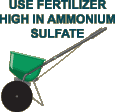As temperatures begin to rise at spring time, you may begin to notice your lawn changing color yet again. The color change is the ryegrass wilting from the increased temperatures. Many times people will see this change as a sign of water distress, thus increasing watering time or frequency. Keep in mind the more you nurture your ryegrass at this time, the more difficult it will be to transition back to your hybrid Bermuda. By following these simple steps you should be able to transition your lawn smoothly and more effectively.
Over-Seeded Lawns Non-Over-Seeded LawnsOver-Seeded Lawns
When night time temperatures are consistently above 65 degrees for at least five days, it is time to transition your lawn.
 Begin by lowering your mowing height to gradually remove approximately 50% of the leaf blade. This will create a more open canopy for heat to reach the soil surface and "wake up" the hybrid root system. You also have the option to aerify your lawn. With the use of an aerification machine, small plugs of soil are pulled from the ground. This is another way to get the necessary heat to the root system and encourage hybrid Bermuda to come out of dormancy. Please note, aerification should only be done after May 1st.
Begin by lowering your mowing height to gradually remove approximately 50% of the leaf blade. This will create a more open canopy for heat to reach the soil surface and "wake up" the hybrid root system. You also have the option to aerify your lawn. With the use of an aerification machine, small plugs of soil are pulled from the ground. This is another way to get the necessary heat to the root system and encourage hybrid Bermuda to come out of dormancy. Please note, aerification should only be done after May 1st. Cut back on water for five days. Don't stop watering completely though, the hybrid root system still needs the water. You want to discourage the ryegrass and encourage the Bermuda. By cutting back on water, the ryegrass will begin to show signs of stress, this is good.
Cut back on water for five days. Don't stop watering completely though, the hybrid root system still needs the water. You want to discourage the ryegrass and encourage the Bermuda. By cutting back on water, the ryegrass will begin to show signs of stress, this is good.  Use a fertilizer high in ammonium sulfate. This will weaken the ryegrass even further, but will supply the Bermuda with the nutrients it needs to come out of dormancy more quickly. Be sure to rake all of the remaining ryegrass as it dies out. If it remains on the surface of the lawn it will shade the Bermuda and take longer to green up.
Use a fertilizer high in ammonium sulfate. This will weaken the ryegrass even further, but will supply the Bermuda with the nutrients it needs to come out of dormancy more quickly. Be sure to rake all of the remaining ryegrass as it dies out. If it remains on the surface of the lawn it will shade the Bermuda and take longer to green up.
| over-seeded Lawns | ||
| Season | Times per week | Duration |
| January through March | 1 | 15 to 20 minutes |
| April | 2 | 10 to 15 minutes |
| May through October | 2 to 3 | 15 to 25 minutes |
Non-Over-Seeded Lawns
If you opted to let your lawn go dormant without over-seeding, you will have a much easier time with the spring transition. Beginning in April, or when night time temperatures are consistently above 65 degrees for at least five days, you'll want to make some slight changes in your lawn maintenance.
 Begin by lowering your mowing height only enough to remove the first 1/3 of the leaf blade. Try to avoid scalping at this point, the more leaf remaining at the surface will help absorb sunlight and nutrients. Rake your lawn well to remove any dead grass or thatch that may hinder the sunlight from reaching the new plant growth. Higher temperatures and sunlight are key components to a smooth and effective transition.
Begin by lowering your mowing height only enough to remove the first 1/3 of the leaf blade. Try to avoid scalping at this point, the more leaf remaining at the surface will help absorb sunlight and nutrients. Rake your lawn well to remove any dead grass or thatch that may hinder the sunlight from reaching the new plant growth. Higher temperatures and sunlight are key components to a smooth and effective transition. Fertilize with a 21-7-14 or 16-8-4 ratio fertilizer every 30 days.
Fertilize with a 21-7-14 or 16-8-4 ratio fertilizer every 30 days. Increase watering to twice per week at 15 to 20 minutes each time. Deeper watering will encourage the root system to begin to flourish once again.
Increase watering to twice per week at 15 to 20 minutes each time. Deeper watering will encourage the root system to begin to flourish once again.  Once your lawn begins to come out of dormancy, you may also apply "Ironite" to help with the greening process.
Once your lawn begins to come out of dormancy, you may also apply "Ironite" to help with the greening process.
| Non-over-seeded Lawns | ||
| Season | Times per week | Duration |
| January through March | 1 | 15 to 20 minutes |
| April | 1 to 2 | 15 to 20 minutes |
| May through October | 2 to 3 | 15 to 25 minutes |
For more specific watering recommendations visit the University of California Healthy Lawns website.
In This Section
Helpful Information
For questions or to order by phone call:
800-553-8328
Get FREE delivery with orders of 960 sq/ft or more.
Use our Lawn Selector tool to help you select your sod. A few simple questions will tell you which varieties are best suited for your location and your lifestyle.
We'll remind you when it's time to reseed & change your irrigation schedule. You can remove yourself from our list at any time.




